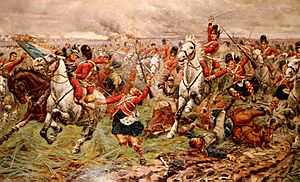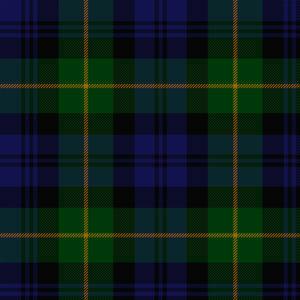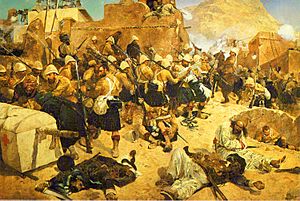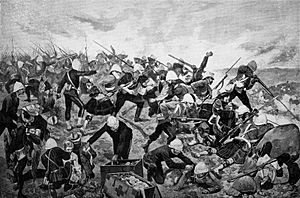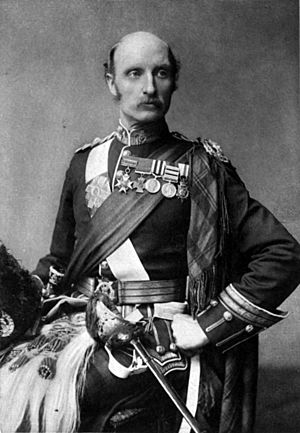92nd (Gordon Highlanders) Regiment of Foot facts for kids
Quick facts for kids 92nd (Gordon Highlanders) Regiment of Foot |
|
|---|---|
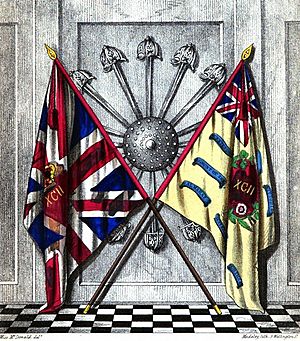
Colours of the 92nd (Gordon Highlanders) Regiment of Foot
|
|
| Active | 1794–1881 |
| Country | |
| Branch | |
| Type | Highland Infantry Regiment |
| Size | One battalion (two battalions 1803–1814) |
| Garrison/HQ | Castlehill Barracks, Aberdeen |
| Nickname(s) | The Gay Gordons |
| Engagements | Napoleonic Wars Crimean War Indian Rebellion Battle of Majuba Hill |
The 92nd (Gordon Highlanders) Regiment of Foot was a special group of soldiers in the British Army. They were an infantry regiment, meaning they fought on foot. This regiment was started in 1794.
Later, in 1881, it joined with another regiment, the 75th (Stirlingshire) Regiment of Foot. Together, they formed a new, bigger group called the Gordon Highlanders. This change happened because of new rules for the army called the Childers Reforms.
Contents
The Story of the Gordon Highlanders
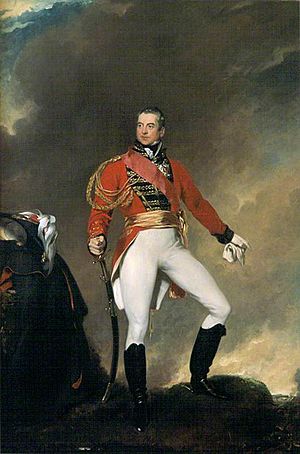
How the Regiment Began
The 92nd Regiment started in a place called Aberdeenshire in Scotland. It was formed by General George Gordon, 5th Duke of Gordon. At first, it was called the 100th (Gordon Highlanders) Regiment of Foot. This happened on February 10, 1794. The reason it was formed was to help protect Britain from the French Revolution.
In September 1794, the soldiers went to Gibraltar. Then they moved to Corsica in June 1795. After some time, they returned to Gibraltar in September 1796. The regiment came back to England in March 1798. But they were soon sent to Ireland in May 1798. Their job was to help stop the Irish Rebellion. In October 1798, the regiment got a new name: the 92nd (Highland) Regiment of Foot.
In August 1799, the regiment sailed to Holland. They fought in the Battle of Alkmaar in October 1799. This was part of a plan to overthrow a French-supported government. They came home later that month. In June 1800, they went to Menorca. Then, in March 1801, they sailed to Abu Qir in Egypt. They were part of the Egyptian Campaign.
They fought in the Battle of Mandora on March 13, 1801. This battle happened before the bigger Battle of Alexandria on March 21. On that morning, the regiment was told to go back. They had only 150 healthy soldiers left because of sickness and injuries. But when they heard fighting, they asked to rejoin the battle. Their commander, Sir Ralph Abercromby, agreed. The regiment sailed home in October 1801.
Fighting in the Napoleonic Wars
In November 1803, a second group of soldiers, called a battalion, was formed. But this group stayed in the United Kingdom. It helped train new soldiers. The first battalion went to Copenhagen in August 1807. They fought in the Battle of Køge and the Battle of Copenhagen. These battles were part of the Gunboat War.
In July 1808, the regiment went to Portugal. They were there to fight in the Peninsular War. They served under Lieutenant-General Sir John Moore. They fought in the Battle of Corunna in January 1809. After the battle, they had to leave the area. The regiment's name changed again in 1809 to the 92nd Regiment of Foot. They then took part in the difficult Walcheren Campaign in late 1809.
The regiment returned to Portugal in September 1810. They continued to serve under General Viscount Wellesley in the Peninsular War. They fought in many battles. These included the Battle of Fuentes de Oñoro in May 1811. They also fought in the Second Siege of Badajoz in June 1811. Other battles were the Battle of Arroyo dos Molinos in October 1811 and the Battle of Almaraz in May 1812. They also fought in the Battle of Vitoria in June 1813.
After these battles, they chased the French Army into France. They fought in the Battle of the Pyrenees in July 1813. Then came the Battle of Nivelle in November 1813 and the Battle of the Nive in December 1813. Their last battles in this war were the Battle of Orthez in February 1814 and the Battle of Toulouse in April 1814.
The regiment went to Europe again in May 1815. This was for the Hundred Days campaign. The regiment played a very important part in the Battle of Quatre Bras on June 16, 1815. They were one of the groups defending a key crossroads. They stopped a French attack with a bayonet charge.
Two days later, the regiment fought again at the famous Battle of Waterloo. Early in the battle, French troops attacked the left side of the Allied line. The 92nd Regiment was ordered to charge the French soldiers. They did, and the French group broke apart. The horses of the Scots Greys, another British cavalry regiment, rode through the 92nd to chase the French. Some soldiers of the 92nd even held onto the stirrups of the passing horses! They wanted to keep fighting the French troops.
A soldier from the Scots Greys said that the Gordons shouted, "Go at them the Greys! Scotland for ever!" He said his "blood thrilled" at this. Many Gordons held onto their stirrups and charged into the fight with them. After the battle, the regiment marched to Paris. They sailed home in December 1815. When they arrived in Edinburgh on September 7, 1816, a large crowd cheered for them.
The Victorian Era Battles
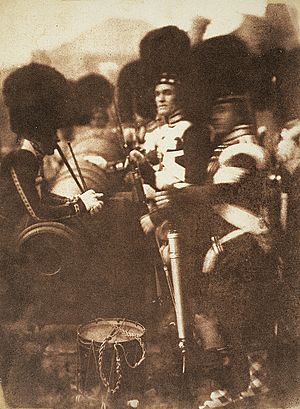
In April 1819, the regiment went to Jamaica. Many soldiers sadly died from yellow fever there. The regiment returned home in 1827. They went to Gibraltar in 1834. Then they moved to Barbados in 1841 before coming home again in 1844.
They were sent to the Ionian Islands in 1851 and to Gibraltar in 1853. From there, they were sent to the Siege of Sevastopol during the Crimean War. But they did not see much serious fighting. In January 1858, the regiment sailed to India. They helped to stop the Indian Rebellion. They had several small fights with rebel groups. In July 1861, the regiment got its original name back: the 92nd (Gordon Highlanders) Regiment of Foot. They sailed home in January 1863.
The regiment returned to India in 1868. In December 1878, they were sent to Afghanistan. They helped with security after the Second Anglo-Afghan War began. In October 1879, they fought in the Battle of Charasiab. The regiment captured three hills, which helped them win the battle. Major George White earned the Victoria Cross for his bravery in this action. Another Victoria Cross was won by Lieutenant William Dick-Cunyngham at the Siege of the Sherpur Cantonment on December 13, 1879.
At the end of August 1880, the regiment marched with General Frederick Roberts. They marched from Kabul to Kandahar. In the Battle of Kandahar on September 1, 1880, they helped lead the attack. They cleared the enemy out of wooded areas near a village.
Instead of going home in 1881, the regiment was sent to Natal. This was to fight in the First Boer War. The regiment was part of the terrible Battle of Majuba Hill on February 27, 1881. About 350 British soldiers, including those from the 92nd, captured the top of a hill. But the next day, they faced heavy fire from 2,000 Boer soldiers. Despite fighting bravely until the very end, the British soldiers were forced off the hill.
As part of army changes in the 1870s, the 92nd was linked with another regiment. This was the 93rd (Sutherland Highlanders) Regiment of Foot. They shared a training base in Aberdeen. On July 1, 1881, new army rules came into effect. The 92nd Regiment joined with the 75th (Stirlingshire) Regiment of Foot. They formed the new Gordon Highlanders regiment. The special flags of the 92nd Regiment were placed in St Giles' Cathedral in Edinburgh. They are still there today.
Battle Honours
These are some of the special awards the regiment earned for its bravery in battles:
- Egmont-Op-Zee
- French Revolutionary Wars: Mandora, Egypt
- Peninsular War: Corunna, Fuentes D'Onor, Almaraz, Vittoria, Pyrenees, Nive, Orthes, Peninsula
- Napoleonic Wars: Waterloo
- Second Anglo-Afghan War: Charasiah, Kabul 1879, Kandahar 1880, Afghanistan 1878–80
Victoria Cross Awards
The Victoria Cross is the highest award for bravery in the British military. These soldiers from the 92nd Regiment won this award:
- George Stuart White
- William Dick-Cunyngham
- Thomas Beach – (He was helping another regiment, the 55th (Westmorland) Regiment of Foot)


